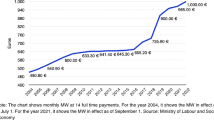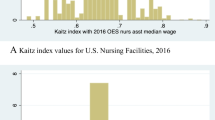Abstract
This paper offers state-level estimates of job loss from increasing the federal minimum wage to $10.10 per hour in 2016. Given the vast differences in nominal wages across geography, a federal increase in minimum wage that is not indexed to local wage levels will have a differential impacts across states. The proposed minimum wage would be binding for between 17 and 18 % of workers nationally. We estimate coverage rates ranging from just 4 % in Washington D.C. to as high as 51 % in Puerto Rico, with 13 states having at least 20 % of the employed population covered by the proposal. Using labor demand elasticities from previous empirical work, these coverage rates imply national employment losses between 550,000 and 1.5 million workers. The range of state estimates shows that states are differentially impacted, with high-end loss estimates ranging between 2.8 % of covered employees in Arkansas to over 41 % in Puerto Rico. Sensitivity analysis highlights that using even a simple methodology with relatively few assumptions for estimating employment loss from minimum wage changes is subject to a high degree of uncertainty.

Similar content being viewed by others
Notes
The Fair Labor Standards Act, which established the minimum wage, currently applies to about two-thirds of workers (CBO 2014).
See http://www.bls.gov/oes/current/oessrcst.htm to download the state-level files detailing the wage and salary distribution.
See http://www.bls.gov/news.release/cpi.nr0.htm for the most current CPI data.
The CBO report inflates the wage and employment distribution by a 2.9 % annual rate up to 2016 to match the $10.10 proposal.
For a thorough review of this literature see Brown et al. (1982).
References
Addison JT, Blackburn ML, Cotti CD (2009) Do minimum wages raise employment? Evidence from the US retail-trade sector. Labour Econ 16:397–408
Addison JT, Blackburn ML, Cotti CD (2013) Minimum wage increases in a recessionary environment. Labour Econ 23:30–39
Allegretto SA, Dube A, Reich M (2011) Do minimum wages really reduce teen employment? Accounting for heterogeneity and selectivity in state panel data. Ind Relat J Econ Soc 50:205–240
Brown C, Gilroy C, Kohen A (1982) The effect of the minimum wage on employment and unemployment. J Econ Lit 20:487–528
Card D (1992a) Do minimum wages reduce employment? A case study of California, 1987–89. Ind Labor Relat Rev 46:38–54
Card D (1992b) Using regional variation in wages to measure the effects of the federal minimum wage. Ind Labor Relat Rev 46:22–37
Card D, Katz LF, Krueger AB (1994) Comment on David Neumark and William Wascher, ‘Employment Effects of Minimum and Subminimum Wages: Panel Data on State Minimum Wage Laws. Ind Labor Relat Rev 47(3):487–96
Congressional Budget Office (2014) The effects of a minimum-wage increase on employment and family income. Accessed at http://www.cbo.gov/sites/default/files/cbofiles/attachments/44995-MinimumWage.pdf
Dube A, Lester TW, Reich M (2010) Minimum wage effects across state borders: estimates using contiguous counties. Rev Econ Stat 92:945–964
Giuliano L (2013) Minimum wage effects on employment, substitution, and the teenage labor supply: evidence from personnel data. J Labor Econ 31:155–194
Katz L, Krueger A (1992) The effect of the minimum wage on the fast-food industry. Ind Labor Relat Rev 46:6–21
Meer J, West J (2013) Effects of the minimum wage on employment dynamics. National Bureau of Economic Research
Neumark D, Wascher W (1992) Employment effects of minimum and subminimum wages: panel data on state minimum wage laws. Ind Labor Relat Rev 46:55–81
Neumark D, Wascher W (1994) Employment effects of minimum and subminimum wages: reply to Card, Katz and Krueger. Ind Labor Relat Rev 47:497–512
Neumark D, Schweitzer M, Wascher W (2004) Minimum wage effects throughout the wage distribution. J Hum Resour 39:425–450
Neumark D, Salas J, Wascher W (2013) Revisiting the minimum wage-employment debate: throwing out the baby with the bathwater? National Bureau of Economic Research
Sabia JJ (2009) Identifying minimum wage effects: new evidence from monthly CPS data. Ind Relat J Econ Soc 48:311–328
Author information
Authors and Affiliations
Corresponding author
Rights and permissions
About this article
Cite this article
Hanson, A., Hawley, Z. The $10.10 Minimum Wage Proposal: An Evaluation across States. J Labor Res 35, 323–345 (2014). https://doi.org/10.1007/s12122-014-9190-8
Published:
Issue Date:
DOI: https://doi.org/10.1007/s12122-014-9190-8




